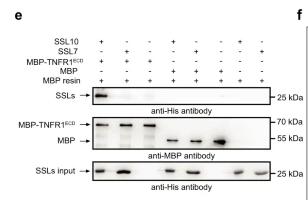AFfirm™ MBP Mouse Monoclonal Antibody - #BF8010
Product Info
*The optimal dilutions should be determined by the end user. For optimal experimental results, antibody reuse is not recommended.
*Tips:
WB: For western blot detection of denatured protein samples. IHC: For immunohistochemical detection of paraffin sections (IHC-p) or frozen sections (IHC-f) of tissue samples. IF/ICC: For immunofluorescence detection of cell samples. ELISA(peptide): For ELISA detection of antigenic peptide.
Fold/Unfold
GDB; Golli MBP; Golli MBP; myelin basic protein; Hemopoietic MBP; HMBPR; HUGO; MBP; MBP_CAVPO; MBP_HUMAN; MGC99675; MLD; Myelin A1 protein; Myelin A1 Protein, basic; Myelin basic protein; Myelin Deficient; Myelin membrane encephalitogenic protein; OTTHUMP00000163776; OTTHUMP00000174387; OTTHUMP00000174388; SHI; Shiverer; SP;
Immunogens
A synthesized peptide derived from human MBP.
MBP isoforms are found in both the central and the peripheral nervous system, whereas Golli-MBP isoforms are expressed in fetal thymus, spleen and spinal cord, as well as in cell lines derived from the immune system.
- P02686 MBP_HUMAN:
- Protein BLAST With
- NCBI/
- ExPASy/
- Uniprot
MGNHAGKRELNAEKASTNSETNRGESEKKRNLGELSRTTSEDNEVFGEADANQNNGTSSQDTAVTDSKRTADPKNAWQDAHPADPGSRPHLIRLFSRDAPGREDNTFKDRPSESDELQTIQEDSAATSESLDVMASQKRPSQRHGSKYLATASTMDHARHGFLPRHRDTGILDSIGRFFGGDRGAPKRGSGKDSHHPARTAHYGSLPQKSHGRTQDENPVVHFFKNIVTPRTPPPSQGKGRGLSLSRFSWGAEGQRPGFGYGGRASDYKSAHKGFKGVDAQGTLSKIFKLGGRDSRSGSPMARR
Research Backgrounds
The classic group of MBP isoforms (isoform 4-isoform 14) are with PLP the most abundant protein components of the myelin membrane in the CNS. They have a role in both its formation and stabilization. The smaller isoforms might have an important role in remyelination of denuded axons in multiple sclerosis. The non-classic group of MBP isoforms (isoform 1-isoform 3/Golli-MBPs) may preferentially have a role in the early developing brain long before myelination, maybe as components of transcriptional complexes, and may also be involved in signaling pathways in T-cells and neural cells. Differential splicing events combined with optional post-translational modifications give a wide spectrum of isomers, with each of them potentially having a specialized function. Induces T-cell proliferation.
Several charge isomers of MBP; C1 (the most cationic, least modified, and most abundant form), C2, C3, C4, C5, C6, C7, C8-A and C8-B (the least cationic form); are produced as a result of optional PTM, such as phosphorylation, deamidation of glutamine or asparagine, arginine citrullination and methylation. C8-A and C8-B contain each two mass isoforms termed C8-A(H), C8-A(L), C8-B(H) and C8-B(L), (H) standing for higher and (L) for lower molecular weight. C3, C4 and C5 are phosphorylated. The ratio of methylated arginine residues decreases during aging, making the protein more cationic.
The N-terminal alanine is acetylated (isoform 3, isoform 4, isoform 5 and isoform 6).
Arg-241 was found to be 6% monomethylated and 60% symmetrically dimethylated.
Phosphorylated by TAOK2, VRK2, MAPK11, MAPK12, MAPK14 and MINK1.
Plasma membrane>Myelin membrane>Peripheral membrane protein>Cytoplasmic side.
Note: Cytoplasmic side of myelin.
Nucleus.
Note: Targeted to nucleus in oligodendrocytes.
MBP isoforms are found in both the central and the peripheral nervous system, whereas Golli-MBP isoforms are expressed in fetal thymus, spleen and spinal cord, as well as in cell lines derived from the immune system.
Belongs to the myelin basic protein family.
References
Application: WB Species: Human Sample: HEK293T cells
Restrictive clause
Affinity Biosciences tests all products strictly. Citations are provided as a resource for additional applications that have not been validated by Affinity Biosciences. Please choose the appropriate format for each application and consult Materials and Methods sections for additional details about the use of any product in these publications.
For Research Use Only.
Not for use in diagnostic or therapeutic procedures. Not for resale. Not for distribution without written consent. Affinity Biosciences will not be held responsible for patent infringement or other violations that may occur with the use of our products. Affinity Biosciences, Affinity Biosciences Logo and all other trademarks are the property of Affinity Biosciences LTD.



